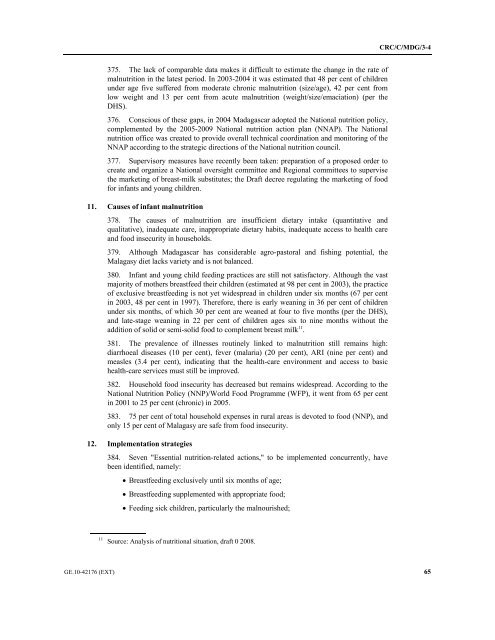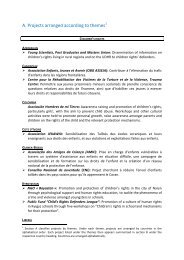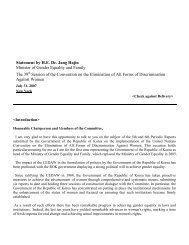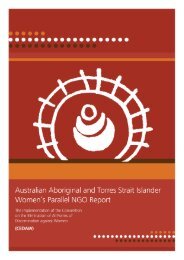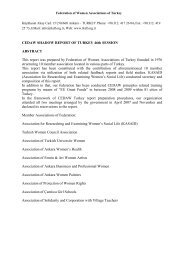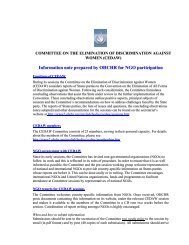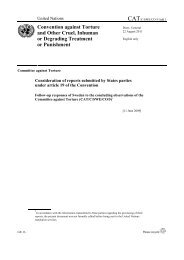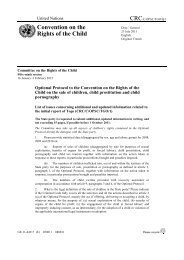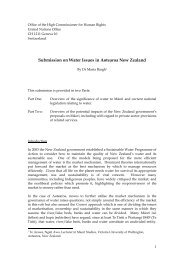CRC/C/MDG/3-4 - Office of the High Commissioner for Human Rights
CRC/C/MDG/3-4 - Office of the High Commissioner for Human Rights
CRC/C/MDG/3-4 - Office of the High Commissioner for Human Rights
Create successful ePaper yourself
Turn your PDF publications into a flip-book with our unique Google optimized e-Paper software.
375. The lack <strong>of</strong> comparable data makes it difficult to estimate <strong>the</strong> change in <strong>the</strong> rate <strong>of</strong><br />
malnutrition in <strong>the</strong> latest period. In 2003-2004 it was estimated that 48 per cent <strong>of</strong> children<br />
under age five suffered from moderate chronic malnutrition (size/age), 42 per cent from<br />
low weight and 13 per cent from acute malnutrition (weight/size/emaciation) (per <strong>the</strong><br />
DHS).<br />
376. Conscious <strong>of</strong> <strong>the</strong>se gaps, in 2004 Madagascar adopted <strong>the</strong> National nutrition policy,<br />
complemented by <strong>the</strong> 2005-2009 National nutrition action plan (NNAP). The National<br />
nutrition <strong>of</strong>fice was created to provide overall technical coordination and monitoring <strong>of</strong> <strong>the</strong><br />
NNAP according to <strong>the</strong> strategic directions <strong>of</strong> <strong>the</strong> National nutrition council.<br />
377. Supervisory measures have recently been taken: preparation <strong>of</strong> a proposed order to<br />
create and organize a National oversight committee and Regional committees to supervise<br />
<strong>the</strong> marketing <strong>of</strong> breast-milk substitutes; <strong>the</strong> Draft decree regulating <strong>the</strong> marketing <strong>of</strong> food<br />
<strong>for</strong> infants and young children.<br />
11. Causes <strong>of</strong> infant malnutrition<br />
378. The causes <strong>of</strong> malnutrition are insufficient dietary intake (quantitative and<br />
qualitative), inadequate care, inappropriate dietary habits, inadequate access to health care<br />
and food insecurity in households.<br />
379. Although Madagascar has considerable agro-pastoral and fishing potential, <strong>the</strong><br />
Malagasy diet lacks variety and is not balanced.<br />
380. Infant and young child feeding practices are still not satisfactory. Although <strong>the</strong> vast<br />
majority <strong>of</strong> mo<strong>the</strong>rs breastfeed <strong>the</strong>ir children (estimated at 98 per cent in 2003), <strong>the</strong> practice<br />
<strong>of</strong> exclusive breastfeeding is not yet widespread in children under six months (67 per cent<br />
in 2003, 48 per cent in 1997). There<strong>for</strong>e, <strong>the</strong>re is early weaning in 36 per cent <strong>of</strong> children<br />
under six months, <strong>of</strong> which 30 per cent are weaned at four to five months (per <strong>the</strong> DHS),<br />
and late-stage weaning in 22 per cent <strong>of</strong> children ages six to nine months without <strong>the</strong><br />
addition <strong>of</strong> solid or semi-solid food to complement breast milk 11 .<br />
381. The prevalence <strong>of</strong> illnesses routinely linked to malnutrition still remains high:<br />
diarrhoeal diseases (10 per cent), fever (malaria) (20 per cent), ARI (nine per cent) and<br />
measles (3.4 per cent), indicating that <strong>the</strong> health-care environment and access to basic<br />
health-care services must still be improved.<br />
382. Household food insecurity has decreased but remains widespread. According to <strong>the</strong><br />
National Nutrition Policy (NNP)/World Food Programme (WFP), it went from 65 per cent<br />
in 2001 to 25 per cent (chronic) in 2005.<br />
383. 75 per cent <strong>of</strong> total household expenses in rural areas is devoted to food (NNP), and<br />
only 15 per cent <strong>of</strong> Malagasy are safe from food insecurity.<br />
12. Implementation strategies<br />
384. Seven "Essential nutrition-related actions," to be implemented concurrently, have<br />
been identified, namely:<br />
• Breastfeeding exclusively until six months <strong>of</strong> age;<br />
• Breastfeeding supplemented with appropriate food;<br />
• Feeding sick children, particularly <strong>the</strong> malnourished;<br />
11 Source: Analysis <strong>of</strong> nutritional situation, draft 0 2008.<br />
<strong>CRC</strong>/C/<strong>MDG</strong>/3-4<br />
GE.10-42176 (EXT) 65


